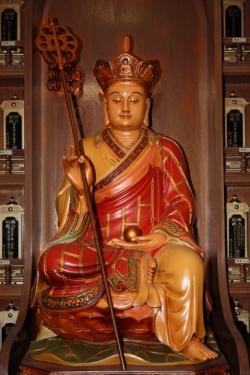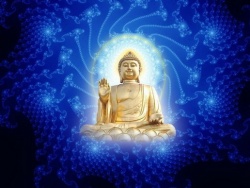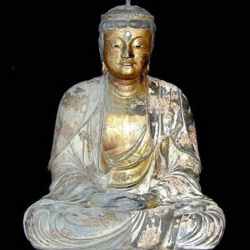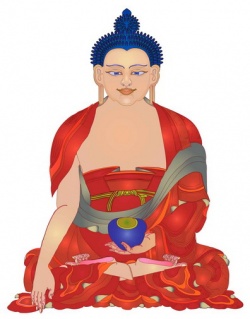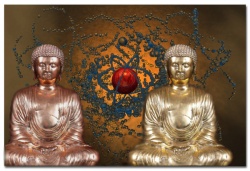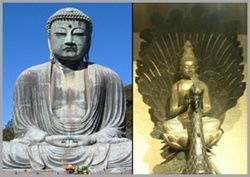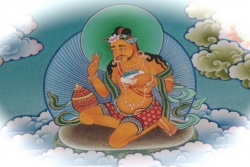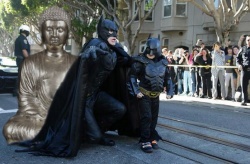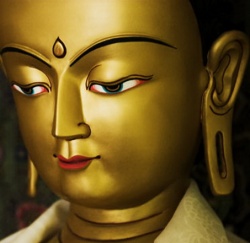Manual of Pramana - Reading Nine: The Concept of Exclusion in Perception
Selection from the collected topics:
The Concept of Exclusion in Perception
The selection here is from a monastic textbook popularly known as The Collected Topics of the Spiritual Son (Sras bsdus-grva), by Master Ngawang Trashi, the spiritual son of the great Jamyang Shepa (1648-1721).
Please note that indented statements are usually those given by the opponent. Responses within brackets are those that are usually left unwritten in the Tibetan text, and are understood to be there because of the context following each.
_______________
Here next is a presentation on the concept of exclusion. On this point, someone may come and make the following claim:
If any one or number of the three kinds of exclusion exists for something, then the exclusion for that thing always exists.
Consider the horns of a rabbit.
Does an exclusion then exist for them?
Because any one or number of the three kinds of exclusion exist for them.
[It doesn't necessarily follow.]
But you already agreed that it does necessarily follow.
[It's not correct to say that the there exist any one or number of the three kinds of exclusion for the horns of a rabbit.]
Suppose you say that it’s not correct.
Consider the horns of a rabbit.
Any one or number of the three kinds of exclusion does so exist for them,
Because there does exist the mental kind of exclusion for them.
[It's not correct to say that the mental kind of exclusion exists for the horns of a rabbit.]
Suppose you say that it’s not correct.
Consider the horns of a rabbit.
The mental kind of exclusion does so exist for them, Because the mental kind of exclusion for them is the image of the reverse of all that is not them which appears to the conceptualization which grasps to them.
[It's not correct to say that the mental kind of exclusion for the horns of a rabbit is the image of the reverse of all that is not them which appears to the conceptualization which grasps to them.]
Suppose you say that it’s not correct.
Consider the horns of a rabbit.
The mental kind of exclusion for them is so the image of the reverse of all that is not them which appears to the conceptualization which grasps to them,
Because they are something that has no nature of its own.
[Then I agree to your original statement: an exclusion does exist for the horns of a rabbit.]
Suppose you agree to our original statement.
Consider the horns of a rabbit.
It is not so, that an exclusion exists for them,
Because there exists for them no exclusion of the kind which is the objectification of a specific instance;
And this is so true, because they are not a working thing. _______________
Suppose someone comes and makes the following claim:
If something is a working thing, then it is always an exclusion of the kind which is the objectification of a specific instance.
Consider a water pitcher.
So is it then an exclusion of the kind which is the objectification of a specific instance?
Because it is a working thing.
[It doesn't necessarily follow.]
But you already agreed that it does necessarily follow.
[Then I agree to your original statement: a water pitcher is an exclusion of the kind which is the objectification of a specific instance.]
Suppose you agree to our original statement.
Consider a water pitcher.
So is it then an exclusion?
Because it is an exclusion of the kind which is the objectification of a specific instance.
[I agree that a water pitcher is an exclusion.]
Suppose you do agree.
So is a water pitcher then a negative thing?
Because it is an exclusion.
[It doesn't necessarily follow.]
But it does necessarily follow,
Because “exclusion” and “negative thing” are terms that refer to the same thing.
[Then I agree to your original statement: a water pitcher is a negative thing.]
But you can’t agree to our original statement,
Because a water pitcher is a positive thing.
_______________
Suppose someone comes and makes the following claim:
The reverse of all that is not a water pitcher is, for a water pitcher, an exclusion of the kind which is the objectification of a specific instance.
Consider the reverse of all that is not a water pitcher.
It is not so true that it is, for a water pitcher, an exclusion of the kind which is the objectification of a specific instance,
Because it is not that existing thing which represents the objectification of a specific instance.
[It's not correct to say that the reverse of all that is not a water pitcher is not that existing thing which represents the objectification of a specific instance.]
Suppose you say that it’s not correct.
Consider the reverse of all that is not a water pitcher.
It is so true that it is not that existing thing which represents the objectification of a specific instance,
Because it is not an existing object which represents the objectification of a specific instance.
[It's not correct to say that the reverse of all that is not a water pitcher is not an existing object which represents the objectification of a specific instance.]
Suppose you say that it’s not correct.
Consider the reverse of all that is not a water pitcher.
So is it then a working thing?
Because it is an existing object which represents the objectification of a specific instance.
You already agreed to this reason.
[It doesn't necessarily follow that, just because something is an existing object which represents objectification of a specific instance, it must always be a working thing.]
But it does necessarily follow,
Because the terms “existing object which represents the objectification of a specific instance” and “working thing” both refer to the same thing.
[Then I agree to your original statement: the reverse of all that is not a water pitcher is a working thing.]
Suppose you agree to our original statement.
It is not so, that the reverse of all that is not a water pitcher is a working thing,
Because (1) all that is not all that is not a water pitcher is not a working thing, and (2) there’s no difference between this and the other.
_______________
Suppose someone comes and makes the following claim:
If there exists for something an exclusion of the kind which is the objectification of a specific instance of the particular object, then there must always exist the reverse of all that it is not.
Consider the two of a pillar and a water pitcher.
So does there exist the reverse of all that they are not?
Because there does exist for them an exclusion of the kind which is the objectification of a specific instance.
[It doesn't necessarily follow.]
But you already agree that it does necessarily follow.
[It's not correct to say that there does exist for the two .]
Suppose you say that it’s not correct.
Consider the two of a pillar and a water pitcher.
There does so exist for them an exclusion of the kind which is the objectification of a specific instance,
Because it would be the existing objects which are the objectification of a specific instance of them.
[Then I agree to your original statement: there does exist the reverse of all that a pillar and a water pitcher is not.]
Suppose you agree to our original statement.
Consider the two of a pillar and a water pitcher.
It is not so true, that there does exist the reverse of all that a pillar and a water pitcher is not,
Because they are a knowable thing which nothing can be.
_______________
Suppose someone comes and makes the following claim:
Consider the two of a pillar and a pitcher.
There does not so exist for them an exclusion of the kind which is the objectification of a specific instance,
Because (1) the two of a pillar and a pitcher is no such thing, and (2) there exists no single such thing which would be distinct from them.
Our answer to this would be, “The latter part of your statement is not correct.”
And this is true because an example of such a thing would be the two of a pillar and a pitcher which is devoid of being both an unchanging and a changing thing.
_______________
Suppose someone comes and makes the following claim:
Whenever you establish something as being, for a water pitcher,
an exclusion of the kind which is the objectification of a specific instance, then you must establish a water pitcher which is devoid of being both an unchanging and a changing thing.
But it’s not so that this is the case,
Because it is allowable to establish the reverse of all that is not a water pitcher as being, for a water pitcher, an exclusion of the kind which is the objectification of a specific instance.
[It's not correct to say that it is allowable to establish the reverse of all that is not a water pitcher as being, for a water pitcher, an exclusion of the kind which is the objectification of a specific instance.]
Suppose you say that it’s not correct.
Consider this same thing.
It is so, for a water pitcher, an exclusion of the kind which is the objectification of a specific instance,
Because it is, for the pitcher, an exclusion.
_______________
Suppose someone comes and makes the following claim:
Whenever we establish something as being, for a water pitcher, an exclusion of the kind which is a negative that involves the absence of something, then we always establish, for a water pitcher, the lack of any self-nature to the person.
But this cannot be the case,
Because we must always establish the exclusion of the kind which is a negative that involves the absence of something, with regard to a water pitcher, as the condition that a water pitcher has nothing about it which is part of all that is not a water pitcher.
And this is so the case,
Because we must establish the exclusion of the kind which is a negative that involves the absence of something, with regard to a cow, as the condition that a cow has nothing about it which is a part of all that is not a cow.
And this is so the case,
Because this is how the Great Book on Valid Perception explains it.
_______________
Suppose someone comes and makes the following claim:
It must be the case that the state of mind which is the reverse of all that is not the state of mind is, for the state of mind, an exclusion of the kind which is the objectification of a specific instance,
Because (1) that water pitcher which is the reverse of all that is not the water pitcher is, for a water pitcher, an exclusion of the kind which is a specific instance of the water pitcher, and (2) the two are similar cases.
Suppose you agree to our statement.
Consider that state of mind which is the reverse of all that is not the state of mind.
It must then be the mental kind of exclusion,
Because it is, for the state of mind, an exclusion of the kind which is the objectification of a specific instance.
To this we answer, “It doesn’t necessarily follow.”
_______________
Suppose someone comes and makes the following claim:
Consider a state of mind.
That state of mind which is the reverse of all that it is not is so, for it, an exclusion;
Because it is an existing thing which can be.
Our answer to this is, “We agree.” And this is because, when you are determining how to read this point, it is correct to read it in such a way that you would answer “we agree” to the fact that the state of mind which is the reverse of all that a state of mind is not would be an exclusion for that mind, [and not a "mental kind of exclusion"].
On this particular point, someone might come and make the following claim:
That state of mind which is the reverse of all that is not the state of mind is so a mental kind of exclusion,
Because that state of mind which is the reverse of all that is not the state of mind is an exclusion for that state of mind.
To this we answer, “It doesn’t necessarily follow.” One could though never agree to the statement,
Because anything which is an exclusion for a state of mind is always an unchanging thing.
_______________
Suppose someone comes and makes the following claim:
It is so true that that unchanging thing which is the reverse of all that is not the unchanging thing is the exclusion for that unchanging thing,
Because that water pitcher which is the reverse of all that is not the water pitcher is exclusion for a water pitcher.
Our answer to this is, “It doesn’t necessarily follow.”
And suppose you agree to that statement.
Consider that unchanging thing which is the reverse of all that is not the unchanging thing.
It is not so true, that it is the exclusion for that unchanging thing, Because it is neither the type of exclusion which is a specific instance of the unchanging thing; nor the type of exclusion for the unchanging thing which is a negative that involves the absence of something; nor the mental type of exclusion.
[The first part of your reason is not correct: it's not correct to say that an unchanging thing which is the reverse of all that is not an unchanging thing is not the type of exclusion which is a specific instance of the unchanging thing.]
Suppose you say that the first part of our reason is not correct.
Consider this same thing.
It is not so true, that it is the type of exclusion which is a specific instance of the unchanging thing,
Because it is one example of the lack of any self-nature of the person.
_______________
Suppose someone comes and makes the following claim:
Consider unproduced, empty space.
It is so true, that it is the type of exclusion which is a specific instance of a negative thing which involves the absence of something,
Because it is a type of exclusion which is a negative that involves the absence of something.
To this we answer, “It doesn’t necessarily follow.”
[Please note that this text uses the above unusual spelling for "unproduced" several times, so we have left it as is.]
Suppose someone else, in response to this exchange, comes and makes the following claim:
Consider a negative thing which involves an absence.
It is so true, that anything which is an exclusion for it is that type of exclusion which is a specific instance for it,
Because there does exist an exclusion for it.
To this we answer, “It’s not correct to say that.” And this is because, when you read this statement, you would have to read it as “there does exist an exclusion for this particular negative involving an absence,” and would therefore have to answer, “It’s not correct to say that.”
_______________
Suppose someone comes and makes the following claim:
Unproduced, empty space is not an exclusion which is a negative thing that involves the absence of something.
Consider unproduced, empty space.
It is so an exclusion which is a negative thing that involves the absence of something,
Because it is a negative thing which involves the absence of something.
[It doesn't necessarily follow.]
But it does necessarily follow,
Because “an exclusion which is a negative thing that involves the absence of something” and “a negative thing which involves the absence of something” both refer to the same thing.
_______________
Here secondly is our own position. Because the terms “exclusion” and “negative thing” refer to the same thing, there is no need to posit a definition for exclusion.
If something is a working thing, then there always exists an exclusion for it which is the objectification of a specific instance. The terms “negative thing which is a working thing” and “an exclusion which is the objectification of a specific instance” both refer to the same thing.
There is always a mental kind of exclusion for anything which is such that it possesses no nature of its own. The terms “mental kind of exclusion” and “object which appears to a conceptualization” refer to the same thing. If a thing can be established as existing, then there is always an exclusion of it which is a negative thing that involves the absence of something. And the terms “exclusion which is a negative thing that involves the absence of something” and “negative thing which involves the absence of something” refer to the same thing.
Identifying Elements of a Logical Statement, and Some Different Classifications of Correct Logical Statements
The following selection is taken from An Explanation of the Art of Reasoning (rTags-rigs), composed by the great tutor of His Holiness the Thirteenth Dalai Lama named Purbuchok Jampa Tsultrim Gyatso (1825-1901).
_______________
This bring us to the section where we identify the reason, the quality to be proven, and the subject. We proceed in two steps: presenting our position, and then putting forth proofs to support our position. Here is the first.
The expression “because there is no fire” is a logical reason for proving that there is no smoke on the surface of an ocean in the middle of the night in a proof where “because there is no fire” serves as the reason in the proof. “Because there’s no fire” is not a logical reason for the same proof where that same term serves as the reason in the proof.
The expression “there is no smoke” is both (1) the quality to be proven in that same proof, where “because there is no fire” serves as the reason; and (2) that which is considered the explicit form of the quality to be proven for the same proof. The expression “it’s smokeless” is neither of the two. This same pattern applies for the expressions such as “there are no trees” and so on.
The expression “because there is no water pitcher perceived to be there by any valid perception” is a logical reason for proving that there exists no water pitcher in a particular location where no water pitcher is perceived by any valid perception to be present. The expression “there exists no water pitcher there” is both (1) the explicit form of the quality to be proven in the same proof, where “because there is no water pitcher perceived to be there by any valid perception” is acting as the reason; and (2) that which is considered the explicit form of the quality to be proven in the same proof. This pattern follows for other cases as well.
A “flesheater spirit” [a preta, or tormented spirit) is a main element in the quality which is denied in a proof that, in the location before us, there can exist no recollection whose perception corresponds to reality, and which ascertains a flesheater spirit, in the mind of a person for whom flesheater spirits are abstruse objects. This same term though is not the “quality which is denied” itself.
The existence, in the mind of a person for whom flesheater spirits are abstruse objects, of a recollection whose perception corresponds to reality, and which ascertains a flesheater spirit, is both (1) the quality which is denied in this particular proof, and (2) a main element in the quality which is denied in the same proof.
The term “smoke” is a main element in the quality which is denied in a proof that there is no smoke on the surface of the nighttime ocean, but it is not the quality denied in the same proof.
The “existence of smoke in that particular place” is both (1) a main element in the quality which is denied in a proof that there is no smoke on the surface of the nighttime ocean, and (2) the quality which is denied in the same proof. “An unchanging thing” is a main element in the quality which is denied in a proof that sound is not an unchanging thing, but it is not the quality which is denied in the same proof.
Here next is the second major point from above. Correct reasons may also be classified according to the quality to be proven. Here there are two types: correct positive reasons, and correct negative reasons.
Here are their respective definitions. First comes the definition of a correct positive reason for any particular proof:
Something which is (1) a correct reason for a particular proof; and (2) which is such that there can exist one thing which is both (a) the object which is considered the explicit form of the quality to be proven in the proof where it acts as the reason, and (b) a positive thing.
These kinds of reasons may be divided into two types of their own: correct reasons that involve a result, and correct reasons that involve a nature.
Anything which is one of these two types of reasons is always a positive reason.
The definition of a correct negative reason for any particular proof is as follows:
Something which is (1) a correct reason for a particular proof; and (2) which is such that there can exist one thing which is both (a) the object which is considered the explicit form of the quality to be proven in the proof where it acts as the reason, and (b) a negative thing.
The terms “correct negative reason” and “correct reason for proving the absence of something” both refer to the same thing.
It is contradictory for one thing to be both a correct negative reason for a particular proof and also a correct positive reason for the same proof. It is not contradictory though for one thing to be both a correct negative reason and a correct positive reason. And this is because the expression “a thing which is made” can be both: it is both a correct negative reason for proving that sound is not an unchanging thing, and it is a correct positive reason for proving that sound is a changing thing.
Next is the third major point from above. Correct reasons may also be classified by according to how the proof is made. Here there are five different types:
1) Correct reasons for proving the meaning;
2) Correct reasons for proving the term;
3) Correct reasons for proving the meaning alone;
4) Correct reasons for proving the term alone; and
5) Correct reasons for proving both the meaning and the term.
We will discuss these reasons in three parts: their definition, typicial example, and supporting logic.
Here first is the definition of a correct reason for proving the meaning in any particular proof:
Something which is both (1) a correct reason for a particular proof; and (2) which is such that there can exist one thing which is both (a) the explicit form of the thing considered the quality to be proven for the particular proof in which it serves as the reason, and (b) a definition.
The definition of a correct reason for proving the term in any particular proof is as follows:
Something which is both (1) the same as the first part above; and (2) which is such that there can exist one thing which is both (a) the explicit form of the thing considered the quality to be proven for the particular proof in which it serves as the reason, and (b) something which is defined.
The definition of a correct reason for proving the meaning alone in any particular proof is as follows:
Something which is both (1) the same as the first part above; and (2) which is such that there cannot exist one thing which is both (a) the explicit form of the thing considered the quality to be proven for the particular proof in which it serves as the reason, and (b) something which is a thing defined—but which is though such that there can exist one thing which is both (a) the same as part “a” above and (b) something which is a definition.
The definition of a correct reason for proving the term alone in any particular proof is as follows:
Something which is both (1) the same as the first part above; and (2) which is such that there cannot exist one thing which is both (a) the explicit form of the thing considered the quality to be proven for the particular proof in which it serves as the reason, and (b) something which is a definition—but which is though such that there can exist one thing which is both (a) the same as part “a” above and (b) something which is a thing defined.
The definition of a correct reason for proving both the meaning and the term in any particular proof is as follows:
Something which is both (1) the same as the first part above; and (2) which is such that there can exist one thing which is both (a) the explicit form of the thing considered the quality to be proven for the particular proof in which it serves as the reason, and (b) something which is a definition—and there can also exist one thing which is both (a) the same as part “a” above and (b) something which is a thing defined.
“Something which only lasts a moment” is a correct reason for proving the term alone in a proof that sound is a changing thing; but it is not a correct reason in the same proof where “something which is made” is used as the reason. This is because, if something is a correct reason for this specific proof, it must be one and the same as “something which is made.”
“Something which is made” is a correct reason for proving the term alone in a proof that sound is a changing thing, when this proof is presented to a correct opponent who has already established, through a valid perception, that sound is a thing that only lasts a moment. Generally speaking though it is a correct reason for proving both the meaning and the term. This is because it is—when presented to an opponent who has not yet ascertained, through any valid perception, that sound is a thing that only lasts a moment—a correct reason for proving both the meaning and the term.
This brings us to the fourth major point, which is classifying correct reasons by the assertion to be proven. Here there are three different types: correct reasons involving deduction; correct reasons involving reasoned belief; and correct reasons involving convention.
The definition of the first is as follows:
Something which (1) a correct reason for the particular proof; and which (2) serves to produce a deductive type of valid perception towards the assertion of the particular reason.
The definition of the second is:
Something which (1) a correct reason for the particular proof; and which (2) serves to produce a valid perception of the type which involves reasoned belief, towards the assertion of the particular reason.
The definition of the third is:
Something which (1) a correct reason for the particular proof; and which (2) serves to produce a valid perception of the type which involves convention, towards the assertion of the particular reason.
The first of these may be divided further into three types: correct reasons which involve a result, a nature, and the absence of something. Respective typical examples would be the following.
1) “Because there is smoke,” a correct reason which involves deduction and is of the result type, for proving that fire exists in a smoky mountain pass;
2) “Because it is a thing which is made,” a correct reason which involves deduction and is of the nature type, for proving that sound is a changing thing; and
3) “Because there is no fire there,” a correct reason which involves deduction and is of the type relating to the absence of something, for proving that there is no smoke upon the surface of the nighttime ocean.
There are also these same three types for the second kind here: those which involve a result, a nature, and the absence of something. Examples here would be:
1) “Because it is scriptural authority which has withstood the three tests,” a correct reason which involves reasoned belief and is of the result type, for proving that the citation “Giving leads to possessions, and morality to happiness” is scriptural authority which is such that the person who spoke it possessed, before he spoke, a valid perception in which he or she realized the truth of what the citation expresses;
2) The same reason, as a correct reason which involves reasoned belief and is of the kind which relates to a nature, for proving that the same citation is unerring about what it expresses; and
3) The same reason, as a correct reason which involves reasoned belief and is of the kind which relates to the absence of something, for proving that the same citation is not erring about what it expresses.
[The "three tests," by the way, are:
1) We have confirmed, with our own direct valid perceptions, those parts of the statement which correspond to "evident" reality;
2) We have confirmed, with our own logical, deductive form of valid perception, those parts of the statement which correspond to "hidden" reality; and
3) We have established that those parts of the statement which correspond to "deeply hidden" reality are free of any internal contradiction or similar faults.]
There are, finally, two types for the third kind here. “Because that’s how people think,” is an example of a correct reason which involves convention and which relates to a nature, to prove that it is nominally appropriate to speak of the moon as the “house of the rabbit.” The same expression, “Because that’s how people think,” is also an example of a correct reason which involves convention and which relates to the absence of something, to prove that it is not literally appropriate to speak of the moon as the “house of the rabbit.” The fifth point is the classification of correct reasons according to how they relate to the group of similar cases. Here there are two types: correct reasons where the set of similar cases and the reason subsume each other; and correct reasons where they relate to each other in two dissimilar ways, [subsuming in one direction, but not in the other].
The definition of the first in a proof that sound is a changing thing is:
A reason where the three relationships hold, and where it and the group of similar cases in that particular proof subsume each other.
The definition of the second in the same proof is:
A reason where the three relationships hold, and where it and the group of similar cases in that particular proof relate to each other in two dissimilar ways.
A definitive example of the first type would be “a made thing,” while a definitive example of the second would be any particular kind of made thing.
The sixth and final division here is that critical one where the classification is made by correct opponent. Here there are two types: correct reasons to use in the context of oneself, and correct reasons to use in the context of others.
The definition of the first is as follows:
Anything which is both (1) a correct reason for proving that sound is a changing thing; and (2) a case where there is no correct opponent for the particular proof in which it serves as the reason.
Whenever the proponent seeks to establish something to his own mind, setting forth “because it’s a made thing” to himself in order to prove that sound is a changing thing, then “because it’s a made thing” is serving as a correct reason to use in the context of oneself, to prove that sound is a changing thing.
The definition of the second type above is as follows:
Anything which is both (1) a correct reason for proving that sound is a changing thing; and (2) a case where there is a correct opponent for the particular proof in which it serves as the reason.
“Because it’s a made thing” is a correct reason to use in the context of others, in proving that sound is a changing thing.
Suppose someone comes and makes the following claim:
“Because it’s a made thing” is both a correct reason to use in the context of oneself, and a correct reason to use in the context of others, in proving that sound is a changing thing.
Consider “because it’s a made thing.”
So is it then the case that there is no correct opponent to whomit can be used as a reason to prove that sound is a changing thing?
Because it is a correct reason to use in the context of oneself.
Now suppose you agree to our statement.
Consider this same thing.
There is so such a correct opponent,
Because this is a correct reason to use in the context of others.
______________
Once again someone may come, to make the following claim:
There is no such thing as a correct reason to use in the context of oneself.
But this is incorrect,
Because in a case where “because it’s a made thing” has actually been employed as a correct reason to use, in the context of oneself, for proving that sound is a changing thing, then “because it’s a made thing’ is then a correct reason to use in the context of oneself.
We can moreover say that there do exist correct reasons to use in the context of oneself, because there does exist a correct reason to use in the context of oneself in order to prove that sound is a changing thing.
[It's not correct to say that there does exist a correct reason to use in the context of oneself in order to prove that sound is a changing thing.]
Suppose you say that it’s not correct.
Consider knowable things.
So is it then the case that, whenever anything is a correct reason for proving that sound is a changing thing, it can never be a correct reason, to use in the context of oneself, in order to prove that sound is a changing thing?
Because you said it was not correct.
Suppose you agree that it can never be.
Consider “because it’s a made thing,” in a case where “because it’s a made thing” has actually been employed as a correct reason to use, in the context of oneself, for proving that sound is a changing thing.
So is it then not a correct reason to use in the context of oneself for this same proof?
Because it is a correct reason for this same proof.
Now all you can do is contradict yourself.
Moreover, isn’t it so that “because it’s a made thing” cannot be a correct reason to use, in the context of oneself, for proving that sound is a changing thing?
Because isn’t it a correct reason to use, in the context of others, to prove the same thing?
And isn’t this the case, because the logical statement given immediately below is a correct logical statement involving a correct reason to use in the context of others?
Consider sound.
It is a changing thing,
Because it’s a made thing.
On this point, someone may come and make the following claim: So is it then true that—in a case where there is no correct opponent for a proof where “because it’s a made thing” is used as a reason to prove that sound is a changing thing—there is in fact a correct opponent for a proof where “because it’s a made thing” is used as a reason to prove that sound is a changing thing?
Because—in a case where “because it’s a made thing” has actually been employed as a correct reason to use, in the context of oneself, for proving that sound is a changing thing—”because it’s a made thing” is a correct reason to use, in the context of others, for proving that sound is a changing thing.
To this we answer, “Your reason is not correct.”
And suppose one did agree to your original statement. So is it then the case that, where there is not something made, there is something made?
Because it is the case that—where there is no correct opponent for a proof in which “because it’s a made thing” is used as a reason to prove that sound is a changing thing—there is in fact a correct opponent for a proof where “because it’s a made thing” is used as a reason to prove that sound is a changing thing.
And you’ve already agreed that this reason is correct.
Suppose someone comes and makes the following claim:
It is true that there does not exist any correct reason to use in the context of oneself. Nonetheless, “because it’s a made thing” is a correct reason to use, in the context of oneself, to prove that sound is a changing thing—in a case where “because it’s a made thing” has actually been employed as a correct reason to use, in the context of oneself, for proving that sound is a changing thing.
But this is incorrect,
Because there must then exist a correct reason to use in the context of oneself; Because there does exist a correct reason to use, in the context of oneself, for proving that sound is a changing thing.
And this is true because—in an instance where “because it’s a made thing” has actually been employed as a correct reason to use, in the context of oneself, for proving that sound is a changing thing—it is the case that (1) a made thing actually does exist, and (2) there does exist in this instance a correct reason to use, in the context of oneself, where “because it’s a made thing” is employed to prove that sound is a changing thing.
You’ve already agreed that the reason is correct.
It is moreover true that there does exist a correct reason to use, in the context of oneself, to prove that sound is a changing thing;
Because there is an instance where “because it’s a made thing” has actually been employed as a correct reason to use, in the context of oneself, for proving that sound is a changing thing.
And this is true because there is a person for whom “because it’s a made thing” has actually been employed as a correct reason to use, in the context of oneself, for this particular proof;
And this is true because there is a person for whom “because there is smoke there” has actually been employed as a correct reason to use, in the context of oneself, for proving that there is fire in a smoky mountain pass.
There is also the logical proof that we use to establish the existence of past and future lives:
Consider the mind of a common person [one who has not yet seen emptiness directly] who is just about to die.
There does exist, as its material result, a later state of mind;
Because it is a state of mind present in the being of a person who still possesses ignorant desire.
It is, for example, similar to the present state of mind.
And consider the mind of an infant who has just been born.
A mind which is of exactly the same type as it has preceded it,
Because it is a state of mind.
It is, for example, like the mind of a very old person.
The Traditional Debating Classes and Subjects
Over the centuries, each major Gelukpa monastery in Tibet has developed its own unique curriculum, all based on the study of the five great books of ancient Indian Buddhism. The structure of the different classes in the debate park is designed around the progressive study of a student in the geshe program through these five great classics, and this is where the core subjects and even the name of the Asian Classics Institute come from.
There are fourteen different debate classes going on simultaneously at Sera Mey Tibetan Monastery, and typically 20 to 22 years is required to pass through the fourteen. Each of the classes has its own special name—something like “freshman” or “sophomore” in the West. At any given night in the debate park, the classes will be huddled in different spots spread around the park.
The best spots (under a couple of especially shady trees in the summer, or up against a protecting wall in windy, cold weather) are given to the higher classes. If a beginning class is very large, the debate master may choose to break it up for the night into two or even three separate groups. Each group starts out with a single attacker and, normally, two defenders; by the end of the night, this may have dissolved into melee of eight or ten attackers bearing down on the original two defenders, with a group of supporters huddled behind them shouting out answers too.
Typical classes at present in Sera Mey might start out with sixty or seventy young men, of whom only a handful—four or five—will actually make it to the end of the geshe program. There is a custom at an advanced point in the curriculum, around ten years into the program, to combine two of the classes from that point on, so that there are enough monks left to make the debates interesting.
The following is a list of the names, durations, and traditional subjects for each of the debate classes at Sera Mey. It was compiled with the help of Khen Rinpoche Geshe Lobsang Tharchin. It should be noted that this is the ideal curriculum, and in the refugee monasteries of southern India events like an unusually long monsoon season, an attack of tuberculosis, sudden changes of plan by monastic officials, extra monastic ceremonies to be attended, a public teaching by a great visiting Lama, or any number of other happenings can conspire to lengthen or shorten the time needed to complete one’s geshe studies.
Year One
Class One: Beginning Class, Collected Topics
This class is Tibetan is known as duchung (bsdus-chung), since it is a beginning (chung) class on the collected topics (bsdus-grva) of Buddhist logic and perceptual theory, mostly according to the “Sutrist” (Sautrantika or mDo-sde-pa) School, which is considered the second of the four schools of ancient India. It is also the higher of the two schools of the Lower Way (Hinayana).
The original root text for this class is the Commentary on Valid Perception (Pramana Varttika, Tsad-ma rnam-’grel), written by Master Dharmakirti (sLobdpon Chos-kyi grags-pa) around 650 AD. The principal monastic textbook is the Collected Topics (Yongs-’dzin bsdus-grva) of the Master Tutor, Purbuchok Jampa Tsultrim Gyatso (1825-1901).
The duration of the class is one year, and begins with a special ceremony of initiation into the debate park. The students are typically around 14 or 15 years old; they have completed some elementary study of the collected topics with their house teacher, and are already familiar with the format of debate (called rikpay grotang [rigs-pa'i 'gro-stangs]). These students have also already learned to read and write (in both the regular and cursive alphabets), and have memorized many of the shorter prayers and texts.
In a pattern which will continue throughout their careers as students in the geshe program, the class moves through a standard series of topics, each with its own name—such as chokchu (phyogs-chos): the study of the subject element in a logical statement, and its relationship to the reason. The class might remain on a particular topic for say one to six weeks, and then move on to the next, according to an undefined, organic schedule dependent on a constant assessment of their progress by the great lamas who are instructing different members of the class.
In the curriculum of the Asian Classics Institute, the topics of this and the next class are represented in the following courses:
Course XIII: The Art of Reasoning
Extension Course 3: Mind and Mental Functions
Year Two
Class Two: Advanced Class, Collected Topics This class is a continuation of the previous, and lasts for a year. Its name is duchen (bsdus-chen), meaning the advanced (chen-po) class on the collected topics (bsdus-grva).
Year Three
Class Three: Beginning Class, First Chapter of the “Ornament”
The name of this class in Tibetan is shungsar (gzhung-gsar), indicating that these students are beginners (gsar-pa) in the first of the great classics (gzhung). The foundation root text here is the Ornament of Realizations (Abhisamaya Alamkara), dictated to the realized being Asanga (‘Phags-pa Thogs-med) by the future Buddha, Maitreya (rJe-btzun Byams-pa) around 350 AD. The principal monastic textbook for this class is the Analysis of the Perfection of Wisdom (Phar-phyin mtha’-dpyod) by Kedrup Tenpa Dargye (mKhas-grub bsTan-pa dar-rgyas), a master from Sera Mey who lived 1493-1568.
These texts present the beliefs of the lower Middle-Way school (the lower half of the fourth or highest school of the four, which itself corresponds to the higher of the two schools of the Mahayana, or Greater Way). This school is known as the Madhyamika Svatantrika (dBu-ma rang-rgyud pa), or “Independent” branch of the Middle-Way, so named because of their belief that we must take an independent object and discuss it in common terms to bring another person to understand correct view. The entire study of this school is called, in the monastery, the “Perfection of Wisdom,” or parchin (phar-phyin) in Tibetan—an abbreviation of the full term, sherab kyi parul tu chinpa (shes-rab kyi pha-rol tu phyin-pa, or prajnya paramita).
This class also lasts for a year, and is devoted to covering only the first third of the first chapter of the root text. (The first chapter is by far the most extensive.) The topics covered in this and the following five classes are represented in the following ACI courses:
Course XV: What the Buddha Really Meant
Year Four
Class Four: Intermediate Class, First Chapter of the “Ornament” This class is a continuation of the preceding. It lasts for a year and is devoted to the second third of the first chapter of Lord Maitreya’s root text. The name of the class in Tibetan is shung-nying (gzhung-rnying), meaning a study of this great classic (gzhung) by students who are now more advanced (rnying-pa).
Year Five
Class Five: Advanced Class, First Chapter of the “Ornament” This class is again a continuation of the preceding. It too lasts for a year, and is devoted to the final third of the first chapter. Its name in Tibetan is shungnying gongma (gzhung-rnying gong-ma), meaning an “even more” (gong-ma) advanced class of more experienced (rnying-pa) students of the great classic (gzhung).
Year Six
Class Six: Class on the Second and Third Chapters of the “Ornament” This class is a continuation of the previous, and covers the second and third chapters of Lord Maitreya’s text. It lasts for one year, and is named kab nyipa (skabs gnyis-pa), since it is devoted to the second (gnyis-pa) and third chapters (skabs) of the root text.
Years Seven and Eight
Class Seven: Class on the Fourth and Higher Chapters of the “Ornament” The study of the Ornament continues in this class, dedicated to the fourth, fifth, sixth, seventh, and eighth chapters of the root text. The eighth chapter is considered especially important because it is dedicated to a thorough description of an enlightened being. The name of this class is kab shipa (skabs bzhi-pa), meaning the students have reached the fourth (bzhi-pa) and higher chapters (skabs) of the root text. Each of the courses from this point on to the end of the geshe program last for two years each.
Years Nine and Ten
Class Eight: Class for Supplementary Topics on the Perfection of Wisdom
The next class is named after and devoted to the study of supplementary topics on the perfection of wisdom known as surkul (zur-bkol), so called because they are extensive treatments of particular subjects which are “extracted” (zur-du bkol-pa) and expanded from much briefer references in the Ornament. The four classic topics here are dependent origination (rten-’brel); the permutations of the flowchart that leads to enlightenment, known as the “community of the twenty” (dge-’dun nyi-shu); the levels of the form and formless realms, along with their corresponding meditational states (bsamgzugs); and the very important study of the art of interpreting statements of the Buddha (drang-nges).
In conjunction with the last, the members of this class will also engage in a separate study of the “foundation consciousness” (kun-gzhi, or alaya vijnyana) concept accepted by the Mind-Only (Citta Matra or Sems-tzam-pa) School, the lower of the two Mahayana schools of ancient India, and third in the overall scheme of four schools. This will in fact be the most time ever spent on the beliefs of this particular school, although it is also touched upon later in the “Middle-Way” courses.
In Sera Mey, the principal monastic textbooks used for the supplementary topics are those on each particular subject composed by the masters Kedrup Tenpa Dargye and Panglung Lobsang Tukje (sPang-lung Blo-bzang thugs-rje, fl. 18th century).
Years Eleven and Twelve
Class Nine: Beginning Class on the Middle Way
Entrance to the ninth class, where a student debater begins his study of the higher half of the Middle-Way School, marks a major change in status. At Sera Mey, it is at this point that the monk earns the right to vote upon questions affecting the monastery at large during the regular assemblies. He has also normally just finished his rikchung examinations, which in effect qualify him to become, in time, a geshe.
In Tibet it was a custom at this juncture for the entire surviving class to approach sponsors and raise the funds to make an important gift to the monastery in appreciation of her kindness. The gift might be a set of rare and important books, new paintings or images for the temple altars, or even a building. Members of the class would also go into deep retreats, intended to accumulate the good karma necessary to grasp the very subtle points of higher Middle-Way philosophy, the next subject in the curriculum. It is considered auspicious if the student encounters difficulty during this retreat (as the sign of an effective attempt to eliminate previous bad karma), and our Root Lama, Khen Rinpoche, has said that he became dangerously ill during his retreat in Tibet at this time.
The name of this class is uma sarpa (dbu-ma gsar-pa), meaning “beginning” (gsarpa) class on the beliefs of the higher part of the Middle-Way (dbu-ma) School.
The root text is Entering the Middle Way (Madhyamika Avatara, dBu-ma la ‘jug-pa), composed by Master Chandrakirti (Slob-dpon Zla-ba grags-pa) around 650 AD.
The principal monastic textbooks used are the Illumination of the True Thought of the Middle Way (dBu-ma dgongs-pa rab-gsal) of Je Tsongkapa, along with its commentary by Kedrup Tenpa Dargye entitled Overview of the Middle Way (dBu-ma spyi-don).
The higher half of the Middle-Way School is known as the “Consequence” (Prasangika, or Thal-’gyur-ba) group, due to their belief that a logical statement utilizing a ridiculous but necessary consequence of an opponent’s erroneous beliefs is especially effective in helping the opponent develop a correct view of emptiness. The entire study of this particular group is called “Middle Way” (Uma, or dBu-ma) in the monastery, although technically the beliefs of the Independent group, already studied, also qualify as “Middle Way.”
The topics covered in this and the next class are represented in the following ACI courses:
Course VI: The Diamond-Cutter Sutra
Course VII: The Vows of the Bodhisattva
Courses X, XI, and XII: A Guide to the Bodhisattva’s Way of Life—Parts One, Two, and Three
Extension Course 4: The Marriage of Emptiness and Karma
Years Thirteen and Fourteen
Class Ten: Advanced Class on the Middle Way
This class is a continuation of the preceding, and in Tibetan is known as uma nyingpa (dbu-ma rnying-pa), meaning “advanced” (nying-pa) class on the beliefs of the higher part of the Middle-Way (dbu-ma) School.
Years Fifteen and Sixteen
Class Eleven: Beginning Class on Vowed Ethics
The class then graduates to the study of vowed ethics (vinaya, or ‘dul-ba); here the curriculum of Sera Mey is unique, since the other major Gelukpa monasteries continue on to higher knowledge (abhidharma, or chos mngon-pa) at this point. This course will cover, extensively, the beliefs of certain groups within the first of the four schools—the Detailist—on the eight different types of vowed morality.
It is only here that a monk learns, in detail, the finer points of monastic rule. The debates of this class are a sharp contrast to the high theoretical dialectic of the Middle Way: here we are more likely to be quoting lists of monastic guidelines, and memorization of the versed summary on the subject is a “must.” This is the Versed Summary on Vowed Morality by Kongpo Ngawang Tsultrim (Shar-chen Kong-po Ngag-dbang tsul-khrims), an eminent lama from the Kongpo College of Sera Mey.
The great commentary of the omniscient Tsonawa (Kun-mkhyen mTso-sna-ba Shes-rab bzang-po), a Kagyupa master from the latter part of the 14th century, will also be studied carefully. Both are based, as is the study of vowed morality throughout Tibet, upon the Summary of Vowed Morality (Vinaya Sutra, or ‘Dul-ba mdo rtza-ba), by the Indian master Guna Prabha (Slob-dpon Yon-tan ‘od), fromabout 500 AD.
The name of this particular class in Tibetan is senkyang dangpo (gzan rkyang dang-po), since in the old days in Tibet it was only (rkyang) by reaching this class that a student was first (dang-po) considered senior enough to wear a heavy sort of monastic shawl (gzan) or cloak called a dagam, on the (very cold) nights of winter in the Lhasa valley.
The topics covered in this and the next class are represented in ACI Course IX: The Ethical Life
Years Seventeen and Eighteen
Class Twelve: Advanced Class on Vowed Ethics
This class is a continuation of the preceding, and is given the name dzindra sumpa (‘dzin-grva gsum-pa), meaning third (gsum-pa) class (‘dzin-grva) fromthe top.
Years Nineteen and Twenty
Class Thirteen: Beginning Class on Higher Knowledge
Year nineteen marks the beginning of the final subject, higher knowledge (abhidharma, known simply as dzu (mdzod) in the monastery). The original root text here is the Treasure House of Higher Knowledge (Abhidharma Kosha, or Chos mngon-pa mdzod), written by Master Vasubandhu (Slob-dpon dbyig-gnyen) in about 350 AD. This work primarily presents the beliefs of the Kashmiri section of the Detailist (Vaibhashika, or Bye-brag smra-ba) School, the first of the four Indian schools, and lower of the two Hinayana schools.
Three monastic textbooks for this subject are featured in the curriculum of Sera Mey:
The commentary of His Holiness the First Dalai Lama, Gendun Drup (rGyal-ba dGe-’dun grub, 1391-1474) entitled Light on the Path to Freedom, an Exposition of Higher Knowledge (Mdzod-tik thar-lam gsal-byed);
A resolution of difficult points on higher knowledge popularly known as The Book on Higher Knowledge by Gyalwang, composed by Gyalwang Trinley Namgyal (rGyal-dbang ‘Phrin-las rnam-rgyal, fl. 1850); and
An exquisite, highly detailed commentary from the Sakya tradition entitled The Chim Book on Higher Knowledge, written by Jampeyang of Chim (mChims ‘Jam-pa’i dbyangs, c. 1280).
The name for this class in Tibetan is dzindra nyipa (‘dzin-grva gnyis-pa), so called because it is the second (gnyis-pa) class (‘dzin-grva) fromthe top.
The topics covered in this and the next class are represented in the following ACI courses:
Course V: How Karma Works
Course VIII: Death and the Realms of Existence
Years Twenty-One and Twenty-Two
Class Fourteen: Advanced Class on Higher Knowledge
This class is a continuation of the preceding, and in Tibetan is called dzindra dangpo (‘dzin-grva dang-po), meaning it is the first (dang-po) class (‘dzin-grva), or the highest class of all. The minimum stay for a person in this class would be two years, but this could stretch out into three, four, or even more years, since a student is required to remain until he can complete his examinations for any of the ranks of a geshe.
Annually for the Entire Geshe Program
Special Winter Classes on Buddhist Logic and Perceptual Theory
Throughout the entire length of a monk’s career in the geshe program, several months in the winter are reserved for special classes on Buddhist logic and perceptual theory, based upon the Commentary on Valid Perception (Pramana Varttika, Tsad-ma rnam-’grel) of Master Dharmakirti (Slob-dpon Chos-kyi grags-pa), who lived about 650 AD.
The principal monastic commentary here is Light on the Path to Freedom, an Explanation of the “Commentary on Valid Perception,” by one of the principal disciples of Je Tsongkapa, Gyaltsab Je Darma Rinchen (rGyal-tsab rje Dar-ma rin-chen, 1364-1432). At Sera Mey, a new commentary by Geshe Yeshe Wangchuk (dGe-bshes Ye-shes dbang-phyug, 1928-1997) is also very popular. Normally each class simply takes its name from whichever major topic it may be debating at the time.
One reason the text by Gyaltsab Je is so widely used is that it is studied in all of the major Gelukpa monasteries, and can thus be used as common scriptural authority during the annual Jang Gunchu, or Winter Debates—a kind of annual Olympic intensive where the best student monks from each of the major colleges can come together to study and debate, almost day and night, for an entire month.
Here all the students from each monastery who are debating the same subject join into a single class, which acts as an excellent preparation for the debates they will have with each other during the geshe examinations down the road. Back home, those from each monastery who did not qualify for the Winter Debates continue on these same general subject; this provides a good opportunity for students of medium or lesser ability to take center stage at the debate park and improve themselves.
The topics for the Winter Debates are represented in the following ACI Courses:
Course IV: The Proof of Future Lives
Course XIII: The Art of Reasoning
Special Teachings by Eminent Lamas
Throughout the geshe program, a student will also attend special teachings given by eminent Lamas, both inside and outside their home monasteries. Actual recent examples at Sera Mey, for example, would be a one month teaching on the steps of the path to Buddhahood (lam-rim) presented by Geshe Yeshe Wangchuk, or a teaching by His Holiness the Dalai Lama on emptiness. The most frequent subjects of these teachings are either lam-rim or lojong: developing the good heart. The content of these special teachings often comes up later in the debate park, in conjunction with almost every other subject. For this reason, the teachings on lam-rim and lojong have been organized into a sixth subject in the ACI curriculum, and are represented in the following courses:
Course I: The Principal Teachings of Buddhism
Course III: Applied Meditation
Course XIV: Lojong, Developing the Good Heart
Extension Course 1: Offering of the Mandala
Extension Course 2: Contemplations on the Practice of Giving and Taking (Tong-Len)
Extension Course 5: Lord Atisha’s Lamp for the Path to Enlightenment
Extension Course 6: The Garden—Discussions with the Great Masters of Buddhism
_______________
The invasion of Tibet led to a great deal of disruption in the debate classes. For twelve years after the fall of Tibet in 1959, the surviving monks from all of the major Gelukpa monasteries were thrown together in the Buxall refugee camp in northeastern India. Only several hundred of over 10,000 student monks from Lhasa lived through the invasion and subsequent horrors of the Buxall camp, to reach their new home in south India.
In the early 1970′s, land was found in the Karnataka area of south India for the re-establishment of these major monasteries. (Khen Rinpoche’s older brother, a Tibetan government official, was instrumental in locating and securing the land.) The debating classes and geshe examinations continued throughout this time in a very tenuous way, and by the mid 1970′s it looked as though there would not be enough support for themto be carried on at Sera Mey. This is when Khen Rinpoche began the food fund for students in the geshe program, which proved to be a deciding factor in their survival. Khen Rinpoche and his students also provided a great deal of the support needed to revive the Winter Debates in India. The debate classes throughout the great Gelukpa monasteries of south India now thrive, and the level of study is said to rival that of Old Tibet.
Supplement to Reading Nine
Rikpay Drotang
Debating Format, Part Two
(Continued from the previous reading:)
Bumpa mitakpa yinpar tel.
Are you telling me a water pitcher is a changing thing?
Du!
That’s right!
Mayinpar tel,
No it’s not,
Bumpa chu yinpay chir.
Because a water pitcher is a dharma—an existing thing.
Kyappa ma jung.
It doesn’t necessarily follow.
Chu yinna, mitakpa mayinpe makyappar tel!
Are you telling me that, just because something is an existing thing, it doesn’t have to be a changing thing?
Du!
That’s right!
Gare shak?
Then show me something like that!
Tongpa nyi chu chen.
Consider emptiness.
Mitakpa mayin te,
It’s not a changing thing,
Takpa yinpay chir.
Because it’s an unchanging thing.
See also
- Manual of Pramana - Reading One: Why Study the Art of Reasoning?
- Manual of Pramana - Reading Two: An Outline of All Existing Things
- Manual of Pramana - Reading Three: Quality and Characteristic
- Manual of Pramana - Reading Four: Causes and Results
- Manual of Pramana - Reading Six: Negative and Positive
- Manual of Pramana - Reading Seven: Contradiction and Relationship
- Manual of Pramana - Reading Eight: Definitions and the Things They Define
- Manual of Pramana - Reading Nine: The Concept of Exclusion in Perception
- Manual of Pramana - Reading Ten: The Concept of Time
- Manual of Pramana - CLASS NOTES part 1
- Manual of Pramana - CLASS NOTES part 2
